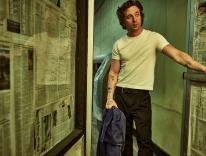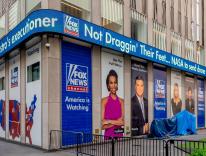
Americans fifty and up will recall the notorious 1989 case of five teenagers of color accused of brutalizing a white woman jogging in New York’s Central Park. At a time of surging violent crime in U.S. cities, the attack spawned a scary term, “wilding,” that fueled white fear of young black men as malign predators; the nightly news, showing the five suspects being hustled out of a police station, heads down, inscribed in the white collective mind an image of guilt that their confessions and subsequent convictions only reaffirmed.
Except that they didn’t do it.
Ava DuVernay’s four-part Netflix docudrama, When They See Us—the title evokes the distorting lens of racial bias—chronicles how five young American males of color were railroaded into confessing to a crime they didn’t commit. Held without food or sleep, kept isolated and mostly without legal representation, they were badgered by detectives who continually promised that if they would implicate others in the group they could “go home.” “Let’s make a deal,” a cop says to one of the boys. “You give something, you get something.” Eventually they caved in and assented to confessions spoon-fed to them by investigators. It was a textbook case of faulty interrogation techniques, driven by a cynical heedlessness born of racism. Psychologists and criminologists have amply documented the ability of innocent arrestees to provide false confessions, once they are broken down. In the event, all five quickly recanted their stories, but it was too late.
The case brings back the poisonous zeitgeist of late-1980s New York, where a new über class of wealthy young Wall Streeters disported itself amid the wreckage of a crack-cocaine epidemic among the city’s underclass. Violent crime reached levels unimaginable today (the city suffered 2,250 murders in 1990; twenty-five years later, just 330); looking back in 2002, New York Times columnist Bob Herbert described “a city soaked in the blood of crime victims.... [where] rapists, muggers and other violent criminals seemed to roam at will.” The Central Park jogger attack brought to the surface a latent social narrative among the city’s dominant classes—that of wild young black men preying on white people—and energized whites to vehement outbursts of self-righteous race anger. “This was a proxy war,” New York Times reporter Jim Dwyer recalled years afterward. In that war, Kevin Richardson, Antron McCray, Yusef Salaam, Raymond Santana, and Korey Wise—who ranged in age from fourteen to sixteen—didn’t stand a chance.
With a few important differences (more on that shortly), DuVernay follows in the steps of the 2013 Ken and Sarah Burns documentary, The Central Park Five. But fictionalization allows her to deepen the portrayal of the characters and their families, adding immensely to the story’s power. When They See Us informs, challenges, and moves a viewer in equal measure, capturing the nuances of the human story even as it lodges a pointed political critique of race and the justice system. It isn’t easy to be forcefully accusatory without sentimentalizing. This is the rare work whose beauty arises from focused moral anger.
Central is the question of perspective: Whose lens will be used to view these events, whose viewpoint privileged? Who is seeing—and characterizing—whom? Putting forth a belated counter-narrative to the dominant (white) narrative that proved so damning in 1989, Part One quickly establishes the routine innocence of the boys, their preoccupation with sports and girls and clothes. DuVernay is similarly at pains to reinscribe “wilding” as an innocent term: “They probably just wilding out,” says one of the boys, as a group of laughing kids rushes by. Does wilding involve some aggressiveness? Yes, and DuVernay portrays it: the badgering of two bike riders in the park; the unprovoked pummeling of a white guy. But such incidents are far from a brutal rape; and in any case, none of the five boys ultimately charged with the rape did any of the aggressive wilding, either.
The early scenes, which show us each boy in his own individual life, take a trope of disaster films—who happens to get on the plane, and who doesn’t?—and deploy it to profound dramatic effect. We see Korey flirting with his girlfriend at a fast-food restaurant as his friend Yusef, heading for the park, stops and pounds on the window, urging him to follow. Korey’s girlfriend tries to persuade him to stay. He hesitates, then leaves; he gets on the plane, a moment of destiny that will be revisited with excruciating regret later on. The get-on-the-plane trope cannily configures what is about to happen as a kind of calamity, a random disaster for which the boys are hardly more to blame than a passenger on a doomed aircraft would be.
Yet that calamity is no act of God, but a creation of human attitudes. As Linda Fairstein (Felicity Huffman), the Manhattan DA’s lead prosecutor on the case, struggles to whip events into shape in her mind, we see a blatantly faulty syllogism emerge: a brutal attack happened in the park; these black male teens were in the park; therefore, these black kids committed the brutal attack. That’s a logical fallacy a ten-year-old could see through, right? Wrong. What’s missing is the underlying assumption supplied by racial bias: that these young black men are the type to do this; that they were up to no good. And so the presumption of innocence is vaporized by the hot glare of racism.
When They See Us delivers a lesson in the mechanics—the linguistics, really—of dehumanization, whereby groups in power marginalize others through invidious language. Police, prosecutors, and the press refer to “these animals” who “rampaged” and “terrorized,” a “wild pack,” all pitted against—as Fairstein puts it—“our lady jogger.” (Such language sprang up among whites irrespective of political orientation; the liberal New York Times, in an editorial, referred to the accused boys as “a savage wolf pack.”) No one would want to minimize the suffering of the victim, a young investment banker named Trisha Meili (and one of the many hard-to-watch scenes in this series is her halting, limping, and profoundly damaged appearance at the trial). But DuVernay makes crystal-clear how her suffering was exploited and wielded to preempt any fair inquiry into whether these boys did it.
The interrogations of the boys—in which they are relentlessly browbeaten and at times physically beaten—raise the question: What did the cops think they were doing when they extorted these confessions? Did they believe these kids committed the crime? Or did they think it didn’t matter? In other words, was the calamity a matter of cynical villainy, or merely grotesque error? Dwyer, in an otherwise approving review of the series, points to what he views as significant simplifications in its depiction of the investigation. Citing “bungling by the authorities,” he notes that while the boys’ confessions didn’t align with the actual details of the assault on the jogger,
the police and prosecutors are portrayed as immediately aware of these discrepancies. That is false. Chaos does not get its due.... The tunnel vision that took over the investigators is rendered solely as amoral ambition, but the reality of error in the Central Park case, as in most everything, is more interesting and nuanced than cartoon villainy.
There’s been much coverage of the belated pushback currently aimed at Linda Fairstein, who vehemently disputes the show’s villainous portrayal of her and accuses DuVernay of “misrepresenting the facts in an inflammatory and inaccurate manner.” The writers of a recent New York Times article assert, like Dwyer, that the script “took liberties” with its depiction of the investigation. And the Ken Burns documentary suggested that apart from a few detectives so fanatically bent on conviction that they didn’t care about actual innocence or guilt, most of the white people involved—prosecutors, press, outraged citizens—honestly believed the five were guilty.
For white liberal viewers, these questions of individual intent may loom as central; only by understanding intent, many will insist, can we assess the complicity of those who rammed through the confessions and convictions in the case. This issue may matter less to viewers of color. One stinging question that the current discourse on race has put in the face of white liberals is: Who cares about your intentions, given the fact of systemic racism? A white progressive’s idea of himself, in this view, is a kind of epiphenomenon, a squiggly decoration prettifying a rotten cake. And to be sure, a minute sifting of the intentions of those who helped engineer false verdicts is likely to seem less than crucial to someone serving a sentence for a crime he didn’t commit.
In the end, it may be a distinction without a difference, given the ugly reality of the mass racial groupthink that determined the case’s outcome. Like the Ken Burns documentary, When They See Us is a study in what cognitive psychologists call confirmation bias. As long as you assume the five must be guilty, their confessions seem damning; assume, however, that they might well not be guilty, and suddenly all sorts of flaws and contradictions appear. The problem was that no one who mattered in the Central Park case—in either the justice system or among politicians and the press—made this key assumption. Indeed, even when a convicted rapist stepped forward, years later, and confessed to the crime (a confession confirmed by DNA), many investigators refused to back down. And in 2002, when Manhattan DA Robert Morgenthau, acknowledging “troubling discrepancies” in the original confessions, let the convictions be vacated, he was reviled by many. (When I interviewed Morgenthau in 2013 for a magazine profile, he called this case the low point of his nearly seventy-year career in law.)
The first half of When They See Us covers the night in the park and subsequent arrests, interrogations, and trial; the second (with adult actors replacing the younger actors of the earlier scenes) engages the long aftermath, including hard years spent in prison. There are mordantly enjoyable metatextual ironies, including Felicity Huffman, currently involved in the real-life college-admissions scandal, playing Fairstein as ethically bankrupt. Donald Trump appears as well; the loudmouth developer—then in his forties—takes out full-page ads in all four big New York papers, urging the death penalty. “They got to get that bigot off TV,” says one of the boys’ mothers. “Don’t worry,” responds another, “his fifteen minutes are almost up.” If only. What seems like a toss-off irony has a deeper point—namely, that whatever hope of exoneration the future might hold for these five, and whatever reforms might ensue from the injustice they suffered, the crass and punitive racism of many in power is far from over. Indeed, the worst of them shall become the first of them, and this knowledge casts a pall of additional pessimism over an already gloomy moral landscape.
However powerful the first two segments of the series, the last two are more harrowing still. Part Three takes us through the indignities that afflict the recently incarcerated. The attempt to find work yields interviews that end quickly once the men’s record is revealed. Raymond ends up dealing drugs. Yusef is stunned to find that he can’t get certified as a teacher or EMT. “Once you been inside, man,” his barber informs him, “they got you. And they keep you.” Dedicating fully half the series to the post-incarceration period, DuVernay expresses the critique of mass incarceration that has been formulated in the years since this event, suggesting that recently released inmates are deprived of the means of making an honest living as part of a system bent upon returning them to prison. The critique of race has developed greatly since 1989, when there was no Innocence Project, no Black Lives Matter, no New Jim Crow, no Michelle Alexander or Ta-Nehisi Coates, no mainstream talk of reparations, no Bryan Stevenson and the National Memorial for Peace and Justice in Alabama, no Museum of African American history in Washington, and on and on. Duvernay’s film is the child of these developments. She operates in a conceptual framework that barely existed back then—among white people, that is.
Part Four, which follows the travails of the one boy, Korey Wise, who was tried and convicted as an adult, is the hardest to watch. There are poignant scenes between Wise and his mother, who visits him in prison; she’s wracked by remorse, while he struggles to hide how brutally he’s being treated by inmates and guards alike. A relatively hopeful interlude, in which one kindly guard plays his protecting angel, alternates with periods in solitary confinement, where Wise’s mind circles relentlessly back to that night and his fateful decision not to stay with his girlfriend in the fast-food restaurant. In one fantasy sequence, filled with grief-struck yearning, we see him bursting out of his cell to find himself with her in Coney Island, enjoying a blissful day. In Wise’s videotaped confession—which closely follows the actual tape as seen in the Burns documentary—we see the boy continually rubbing his face and eyes, as if trying to wake himself from a nightmare. But there is no waking. In prison Wise eventually stops going to his own parole hearings, and vows to “max out” his sentence, knowing that early release requires admitting remorse for a crime he didn’t commit. His and the others’ obdurate refusal to renounce their innocence, even with freedom at stake, testifies eloquently to the deep human need for justice.
The close of the series, following the confession made by the real Central Park rapist, brings legal exoneration and financial restitution; the men sue the city and are awarded $41 million in damages. Yet what has gone before makes true catharsis all but impossible, for them and for us. To a man they come across as gentle souls, remarkably free of bitterness even as they remain fully aware of the price they have paid in lost years. “You can’t get that back,” Raymond’s father says to him. “You just gotta move forward.” (You can see the actual men discussing their experiences together with the actors who play them.)
The ambivalent close reflects a basic dilemma: What should we focus on when we look at race in the United States? Should it be the fact that recent decades have brought a lessening of overt forms of racism, some acceptance of critiques of systemic racism, and socioeconomic and educational progress for some Americans of color? Or should the focus be on the moral outrage of racism and slavery in the first place, and on how long it has taken to eke out even a minimal acknowledgment of the central role played by that outrage in our national creation myth, and in the ongoing workings of our nation itself?
As DuVernay reminds us, the answer to such questions depends on identity; what you choose to look at depends on who you are. For what it’s worth, I—middle-aged upper-middle-class white male—don’t take issue with any critique that lays bare America’s foundationally racist history and structures. I do differentiate between past and present, though; that is to say, I believe progress is possible and that progress has indeed happened. African Americans, meanwhile, are far more likely to view America as ineradicably racist, and to see white racism as something that Americans of color can at best live with—managing it, coping with it, the way one lives with a chronic disease.
It’s an apt metaphor, and DuVernay’s taut and sorrowful drama delivers an acute diagnosis of how it has afflicted this nation, while reminding us—if we should need reminding—that it is not the business of white Americans to instruct black Americans on when, how, where, or indeed whether at all, to feel hope.
Please email comments to [email protected] and join the conversation on our Facebook page.
Previous Story
Stumbling toward War
Next Story
‘Turn the Page’


